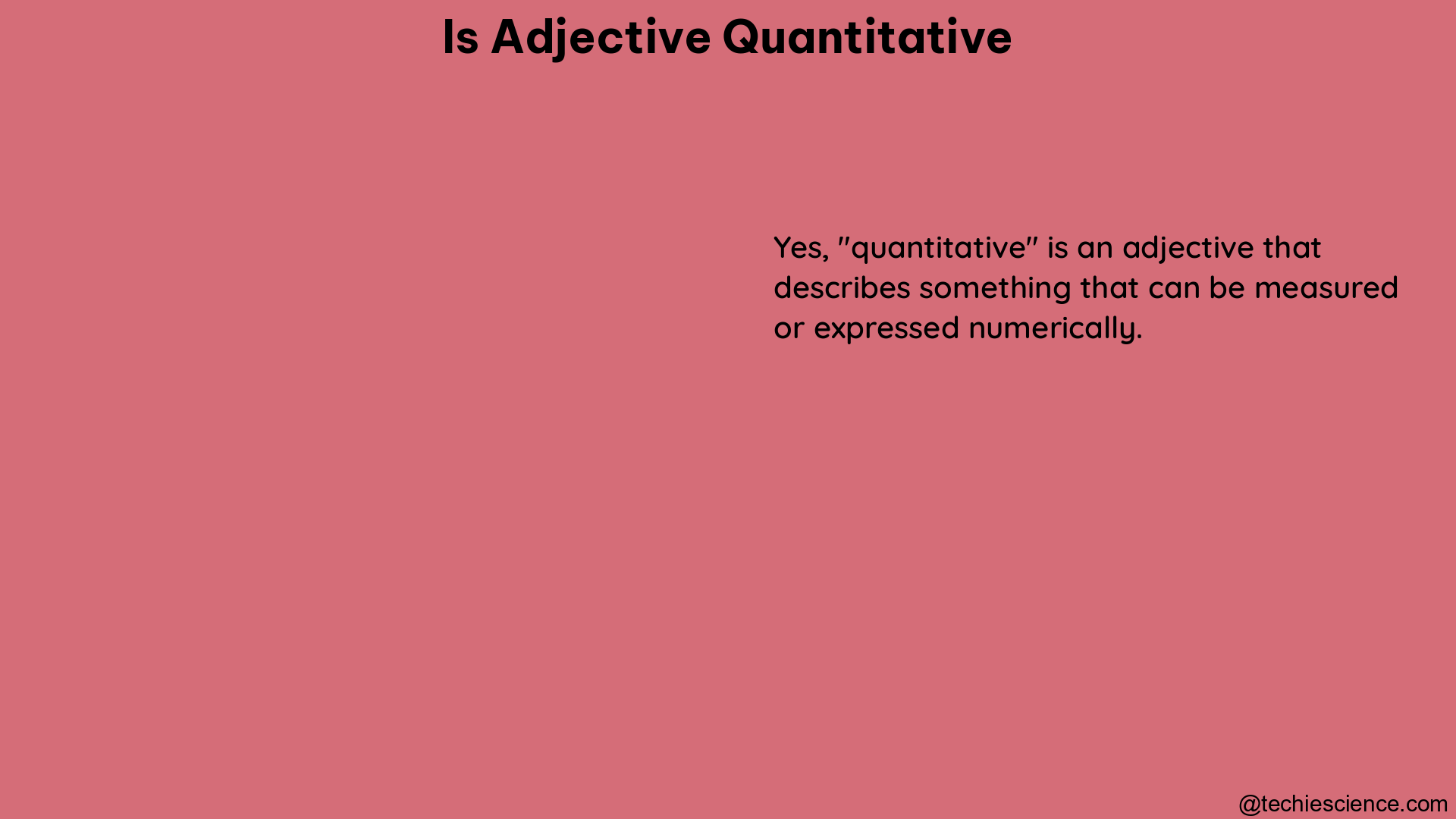The adjective “quantitative” is a term used to describe adjectives that indicate a quantity or number of a noun or pronoun. These adjectives answer questions like “how many?” or “how much?” and provide specific information about the amount or number of something.
Definition and Types of Quantitative Adjectives
Quantitative adjectives can be categorized into two main types:
1. Definite Quantitative Adjectives
Definite quantitative adjectives indicate a specific or exact number or amount. These include:
- Cardinal Numbers: one, two, three, four, five, ten, hundred, thousand, etc.
- Ordinal Numbers: first, second, third, fourth, fifth, etc.
Examples:
– “I have one book on my shelf.”
– “There are two apples in the basket.”
– “He scored three goals in the match.”
– “The city has thousands of residents.”
2. Indefinite Quantitative Adjectives
Indefinite quantitative adjectives give a general or approximate idea of the number or amount without specifying an exact quantity. These include:
– Some, any, several, few, many, much, most, all, etc.
Examples:
– “Would you like some cake?”
– “Do you have any questions?”
– “There are several options to choose from.”
– “He has many friends.”
– “There isn’t much time left.”
Usage and Placement of Quantitative Adjectives

- Countable Nouns: Quantitative adjectives are typically used with countable nouns that can be expressed in singular and plural forms.
- “Two cars”
- “Five books”
-
“Three cats”
-
Uncountable Nouns: Indefinite quantitative adjectives are commonly used with uncountable nouns that cannot be expressed as discrete units.
- “Some water”
- “Much sugar”
-
“A little patience”
-
Placement: Quantitative adjectives generally come before the noun they modify.
- “Two dogs”
- “Many people”
- “Several books”
Agreement and Comparison of Quantitative Adjectives
-
Agreement: Quantitative adjectives do not change in form to agree with the noun they modify.
-
Comparison: Quantitative adjectives can have comparative and superlative forms to compare quantities.
- “More”
- “Less”
- “Most”
- “Fewest”
Use of Quantitative Adjectives in Questions
Quantitative adjectives are often used in questions to inquire about the amount or number of something.
– “How many students are there?”
– “How much money do you have?”
Importance of Quantitative Adjectives
Quantitative adjectives play a crucial role in providing specific information about the quantity or number of nouns, contributing to the precision and clarity of language when expressing amounts or quantities. By using quantitative adjectives appropriately, you can convey the desired level of detail and enhance the meaning of your sentences.
Advanced Concepts and Nuances
Quantitative Adjectives with Collective Nouns
Quantitative adjectives can be used with collective nouns, which represent a group of individuals or items. In such cases, the adjective may indicate the size or quantity of the group.
– “A herd of ten elephants”
– “A flock of several birds”
– “A swarm of many bees”
Quantitative Adjectives and Measurement
Quantitative adjectives can be used to express measurements, such as weight, length, or volume.
– “A five-pound bag of sugar”
– “A three-meter-long rope”
– “A liter of milk”
Quantitative Adjectives and Fractions
Quantitative adjectives can be used to express fractions, indicating a part of a whole.
– “One-fourth of the pie”
– “Three-fifths of the population”
– “Two-thirds of the project is complete”
Quantitative Adjectives and Percentages
Quantitative adjectives can be used to express percentages, indicating a portion or ratio of a whole.
– “Fifty percent of the students passed the exam.”
– “A quarter of the budget was allocated for research.”
– “Ninety-nine point nine percent of the data was accurate.”
Quantitative Adjectives and Approximations
Quantitative adjectives can be used to provide approximate or rounded quantities, especially when the exact number is not known or not important.
– “About a hundred people attended the event.”
– “Roughly a dozen eggs were left in the carton.”
– “Nearly half of the participants signed up for the workshop.”
By understanding the various nuances and applications of quantitative adjectives, you can effectively convey precise and meaningful information about quantities and numbers in your written and spoken communication.
References
- Oxford Learner’s Dictionaries. (n.d.). Quantitative. Retrieved from https://www.oxfordlearnersdictionaries.com/us/definition/american_english/quantitative
- Colby College. (n.d.). Comprehensive Guide to Adjectives. Retrieved from https://web.colby.edu/italiamo/comprehensive-adjectives/
- LearnGrammar.Net. (n.d.). Examples of Quantitative Adjective. Retrieved from https://www.learngrammar.net/a/examples-of-quantitative-adjective
- IELTS Online Tests. (2023, May 22). Quantitative Adjective definition, usages and examples. Retrieved from https://ieltsonlinetests.com/ielts-grammar/quantitative-adjective-definition-usages-and-examples
- GeeksforGeeks. (2023, April 3). Quantitative Adjective. Retrieved from https://www.geeksforgeeks.org/quantitative-adjective/
Hey! I am Arpita Bose Roy. My qualifications are M.A. in English with B. Ed. in both general education and special education. I have 2 years of experience as a “language analyst” at IIT Kharagpur and 4 years of experience as an “Academic Content Developer” at IIT Kharagpur. Currently, I am working as an academic writer at Lambdageeks.